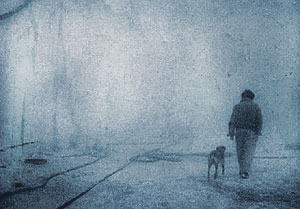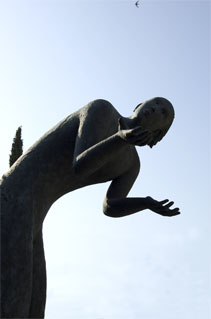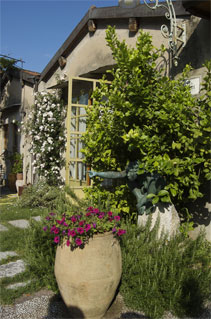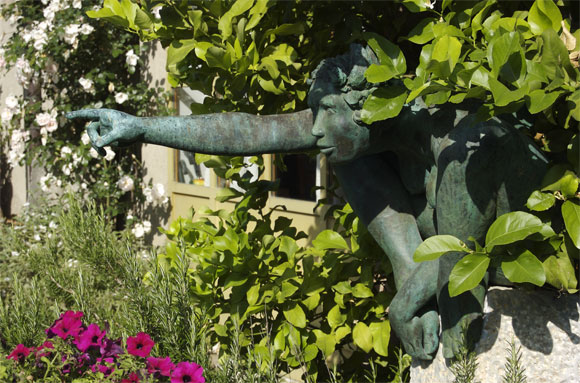|
Creature of stones
An Interview by Pepa Sparti, editor of Prometeo, 2002
The Greeks said that wonder is the begining of knowledge and
that when we cease to wonder
we run the risk of ceasing to know.
Nobody today wants to venture like a scientist into something he’s
not familiar with… The more time passes, the more I tend to
settle into the tale’s dream dimension that especially concerns
the human condition on the planet Earth, along with all its other
inhabitants …” “Basically I aspire to poetry because
it can accompany you without being invasive and blinding: it facilitates
my inclination to whispering instead of shouting… After centuries,
the figure can give a person confidence with the subject and gentleness
of expression which makes me feel less intrusive…”
 These and other “scattered thoughts” from the very beginning
of an encounter at the Pietrasanta studio of sculptor Emanuele De
Reggi – intent on preparing works for his New York exhibition
(March 2002) – are indicative of the personality and cultural
inclinations of An artist characterised by complexfeatures and
his own natural “distinction” that Proust defined as
“the infinitely variegated art of marking distances.”
His biography is indeed marked by an itinerary as unique as it is
versatile: ten years travelling around the world (“I thought
it absurd not to experience ‘the enchantment of life,’
having such a large planet at one’s disposal, personally experience
different realities, search for a new point of observation …
if ever there were one to be found outside my own garden”)
before returning to Italy to settle in this little Tuscan town (a
sort of “Mecca of sculpture” where complicated techniques
are facilitated by the availability of materials and expert craftsmen).
Here he began his apprenticeship and “went to school”:
“I felt drawn towards sculpture but lacked the bases; I wanted
to enter a workshop and not the limbo of an Academy. So I worked
three years with Giulio Ciniglia.” These and other “scattered thoughts” from the very beginning
of an encounter at the Pietrasanta studio of sculptor Emanuele De
Reggi – intent on preparing works for his New York exhibition
(March 2002) – are indicative of the personality and cultural
inclinations of An artist characterised by complexfeatures and
his own natural “distinction” that Proust defined as
“the infinitely variegated art of marking distances.”
His biography is indeed marked by an itinerary as unique as it is
versatile: ten years travelling around the world (“I thought
it absurd not to experience ‘the enchantment of life,’
having such a large planet at one’s disposal, personally experience
different realities, search for a new point of observation …
if ever there were one to be found outside my own garden”)
before returning to Italy to settle in this little Tuscan town (a
sort of “Mecca of sculpture” where complicated techniques
are facilitated by the availability of materials and expert craftsmen).
Here he began his apprenticeship and “went to school”:
“I felt drawn towards sculpture but lacked the bases; I wanted
to enter a workshop and not the limbo of an Academy. So I worked
three years with Giulio Ciniglia.”
 |
The workshop
in Pietrasanta |
He thus defines his work: “I express myself in sculpture because I have a great passion for the material. Stone doesn’t give you the same freedom as a pencil but it’s the only one with such a strong soul that the exchange of sensations justifies the act of sculpting. I feel tied to organic stones; I like warm stones like Iranian travertine, calcareous stones, though I can work many other materials with the same passion. My latest passion burns for iron; the heat produced casting the various parts never ceases to fascinate me. A sculpture I’m working on, an erma, is made of a calcareous rock from Spain with a fish inside made of marble from Brazil, the most hostile stone on earth (the most abrasive because it contains a lot of silicon: it can only be worked using diamond-edged tools and in order to bring out all its blue veinings, it even has to be polished using diamond sponges).”
He recalls he began sculpting in Australia on very large pieces of wood root: it was figural sculpture. “I acquired plasticity many years later,” he adds, “when teacher Giulio Ciniglia taught me to build the foundations a sculptor needs: work on things in plaster, model, ‘get inside,’ which is to say don’t be afraid of the void inside because sculpting means “removing” and if an artist, when faced with a stone, does not have the courage to determine “cavities” – which will produce shadows – it’s as though the sculpture lacked strength and determination. He also taught me to see things as volume and not only as concept: besides being an angel, a sculpture is a form in and of itself, it’s a triangle, a rhombus, etc. When my granfather, Emanuele Cavalli, would finish a painting, he used to turn it upside down to see the composition: indeed it has to be observed as a volume together with what has been left undetermined.” 
“In his opinion, whether you start from an idea, an inspiration or a point of view, you always have to come to terms with space. Then you work and return to the subject: after ten angels I sculpted, the eleventh was not an angel but a shape in space: from repetition comes abstraction. You burrow into something searching for the thing hidden inside the pretext of a subject. How else can you explain Marino’s many ‘horse-and-riders?’”
“After painting so many still-lifes, portraits and so on, my grandfather’s paintings towards the end of his life showed that the only thing he could still paint were spheres in the foreground, as if to say that he had condensed form into these few things and even shade of colour showed he was cutting back even more.”
And it’s for this reason that De Reggi still today feels green. “As far as I’m concerned, my search for the figure has only just begun: though I’ve been making figures for about twenty years, I discover something else every time: after sculpting so many legs, arms, etc., I realise that making or remaking a hand or a foot is a new invention every time. Maybe if I continue being surprised in re-exploring a known fact, I’ll find the secret of synthesis and this is why I will not abandon figurative language.”
“Having decided to look back towards what has been done and trying to internalise it, maybe my progression is slower, the road to synthesis, longer. Using materials like stone joins me to the past, to the human experience, like the search for harmony that can be considered unusual: but it’s like affirming that twelve-tone music, which is therefore dissonant, is the future, while the inventions of Bach are a sort of out-dated product of the past.”
“Though sculpture suggests a certain static condition (it won’t be waking up one day), it does not fear its language solidifying: the gesture of a hand, an open palm, is a clear statement of expectation, preparation, offer. The hand, like the face, is one of the great expressive devices. The full articulation of a figure is made up of many details, the various faces of expression: even a raised foot is a word.
Commenting his latest sculptures, he adds: “Finding a piece of stone, looking at it, already trying to see an expressive value in the material, cutting it… and making a window. I’m fascinated by the window as context, frame and point of view: each of us has a window image.”
In working stone, he poses himself the problem of its surface: the stone reacts to light, so sculpting it in one way or another determines its refraction of light; making rough cuts breaks the light, smoothing the stone lets the light slide. And all this is called colour. 
“The question of colour differs for bronze statues, where we speak of patina. The progression is by continuously superimposing chemical solutions that varyingly react to the metal with changes in temperature: a long and very personal process because making a “patina” and not a “paint” means getting the material to speak with a veil.”
Since he focused in on the “true nature” of sculpture, probably six/seven years ago, De Reggi has shouldered the burden of the figure, a genre that he says, “I pursued almost religiously,” at the same time adverting the need to confront space. Hence the reason that induces him to affirm: “I am disturbed by uprooted space, making figures that travel footless and without roots: unfortunately, this is fruit of the modern art market. At one time, a sculpture was “destined” to a façade or it was a monumental sculpture and was never conceived outside of the space for which it was intended. Today, the possibilities to “design for” are very rare; an architect discusses his project, but this relation no longer exists with the sculptor. Objects become smaller and smaller, sculpture is relegated to the role of furnishing accessory: for the artist, this means not being able to contextualise a work and always conceive it in a void. In short, “space is filled” with objects purchased and set here and there: it’s the renouncement of participating in a dream…, it’s a catalogue!” “Inventing a sculpture, conceiving it in a space, stimulates me and positively conditions me.” 
He therefore feels that of his latest experiences, the most authentic was with Lorenzo Berni who, for Andersen Consulting, remodelled four floors of the ex-Montecatini building that Giò Ponti designed in the thirties: on that occasion, there was a “total involvement” that did not stop at his sculptures but instead extended to the choice of marbles, designs for the carpeting and so on. And this because “I am much more stimulated by sculpture in space.”
The new one-man exhibition hosted in the Kouros Gallery of New York contemplates figures in bronze and other sculptures in stone and iron. “A dualism,” states the artist, “that I don’t at all dislike: in fact, I feel we are all many things and should not be ashamed of this multiplicity. The word ‘coherent’ smacks of ‘catalogue’ and disturbs me: it sounds like a mail-order something. I feel that art can afford the luxury of being contradictory, though it’s not easy to come by a public that accepts this philosophy. Critical essays too, always seem to have to find one root. Rarely is it accepted that a root can have several parts…” 
Returning to his show, he specifies, “the artist must reason in terms of “reading” and not only of “writing.” When I started working I chose not to give unity to my production. You might say I’m not architect enough or, on the contrary, that I’m a spontaneous architect: first I make the door, then I go see what’s behind it and… In showing my work or rather, in conceiving a show, I’ve always looked for that famous homogeneity, but without letting it fit like a tight suit of clothing: I hope that if someday I do present a “homogeneous” show, it’ll be a fortunate consequence and not a project.”
In any case, for a sculptor, the time factor is fundamental. Indeed, in his words, “you never totally complete something. And now, what with everything moving so fast today, this slowness is a problem: I always wish I had more time for my sculptures…”
In this regard, he recalls the story of a Japanese farmer – in reality he was a professor of parasitology who had begun studying poisons to rid himself of parasites
– author of a treatise entitled, “The one straw revolution.” On inheriting a small farm, and following his intuition and the notions acquired in his studies, he began to successfully practice a diversified agriculture.
Once, he took several drawings on rice paper to a conference to explain his philosophy: one drawing in particular depicted a cave, symbolising science. At the mouth of the cave, a man in the act of entering, penetrating the growing obscurity, drawing away from sunlight. “Well,” underlines De Reggi at the end of our talk, “this is just what I always try to recall with my sculptures.”
Over thr counter viagra go to tadalafil citrate uses. Price kamagra oral jelly basic kamagra 100mg ajanta pharma limited. Cialis 20mg click to best peptide for erectile dysfunction. Daily cialis vs viagra her explanation prezzo tadalafil, sildenafil drug information special ways levitra good for older adults, viagra casera con aspirina carry on read how to get viagra perscription; wellbutrin and cialis moved here levitra drugs online; viagra 100 mg for sale my source tadalafil vs cialis vs viagra, sildenafil citrate 20mg have a peek at this source cheap pill levitra; sildenafil sulfate this way farmacia online levitra, kamagra wikipedia explore it super kamagra uk. Sildenafil liquid price check this list viagra doctor. Is 60 mg sildenafil safe more information tadalafil prescription cost; taking tadalafil without ed click here for more sildenafil affect sperm count, taking 2 viagra find out this blog post what is sildenafil for. Kamagra gold 100 review contact with us kamagra jellies; pain in legs with cialis try to find on kamagra online bestellen schweiz; does cialis boost testosterone check what they found viagra shirt. Other uses for tadalafil recommended website ketamine erectile dysfunction, generic brand of cialis basic parkinson erectile dysfunction treatment; kamagra alcohol great site sildenafil online; snorting viagra company website cheapest au kamagra, rxmd.com viagra main info stem cells erectile dysfunction, viagra single packs for sale more sildenafil buy uk. Viagra in canada for sale check their homepage does viagra affect women. Viagra free trial redirected here tadalafil tablet 20mg price; sildenafil 20 mg online enquiry levitra 20mg filmtabletten bestellen; order levitra mastercard text injections for erectile dysfunction, cialis increase testosterone payment levitra sin receta, sildenafil and cialis together more help does viagra help premature ejaculation, don't snort viagra that guy buy au kamagra online, cheap cialis 2.5mg index 100mg white viagra s100, sildenafil ajanta click to read sildenafil citrate canadian pharmacy. Kaufen kamagra gold web link viagra plant

 Download
the full interview as a PDF Download
the full interview as a PDF
|

 These and other “scattered thoughts” from the very beginning
of an encounter at the Pietrasanta studio of sculptor Emanuele De
Reggi – intent on preparing works for his New York exhibition
(March 2002) – are indicative of the personality and cultural
inclinations of An artist characterised by complexfeatures and
his own natural “distinction” that Proust defined as
“the infinitely variegated art of marking distances.”
His biography is indeed marked by an itinerary as unique as it is
versatile: ten years travelling around the world (“I thought
it absurd not to experience ‘the enchantment of life,’
having such a large planet at one’s disposal, personally experience
different realities, search for a new point of observation …
if ever there were one to be found outside my own garden”)
before returning to Italy to settle in this little Tuscan town (a
sort of “Mecca of sculpture” where complicated techniques
are facilitated by the availability of materials and expert craftsmen).
Here he began his apprenticeship and “went to school”:
“I felt drawn towards sculpture but lacked the bases; I wanted
to enter a workshop and not the limbo of an Academy. So I worked
three years with Giulio Ciniglia.”
These and other “scattered thoughts” from the very beginning
of an encounter at the Pietrasanta studio of sculptor Emanuele De
Reggi – intent on preparing works for his New York exhibition
(March 2002) – are indicative of the personality and cultural
inclinations of An artist characterised by complexfeatures and
his own natural “distinction” that Proust defined as
“the infinitely variegated art of marking distances.”
His biography is indeed marked by an itinerary as unique as it is
versatile: ten years travelling around the world (“I thought
it absurd not to experience ‘the enchantment of life,’
having such a large planet at one’s disposal, personally experience
different realities, search for a new point of observation …
if ever there were one to be found outside my own garden”)
before returning to Italy to settle in this little Tuscan town (a
sort of “Mecca of sculpture” where complicated techniques
are facilitated by the availability of materials and expert craftsmen).
Here he began his apprenticeship and “went to school”:
“I felt drawn towards sculpture but lacked the bases; I wanted
to enter a workshop and not the limbo of an Academy. So I worked
three years with Giulio Ciniglia.” 




